Heating that deserves attention! Features of air heating of a private house
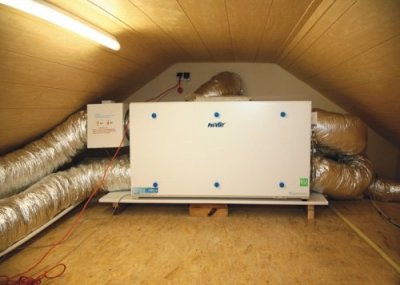
Air heating - widespread in North American countries a method of heating private homes in which air ducts are used instead of pipes and radiators with liquid coolant.
They deliver warm air into the premises from a special heat generator.
According to some sources, air heating is in operation 1.5 times more economical than waterIf desired, ventilation, air conditioning, air purification and humidification systems can be built into it.
The principle of operation of air heating
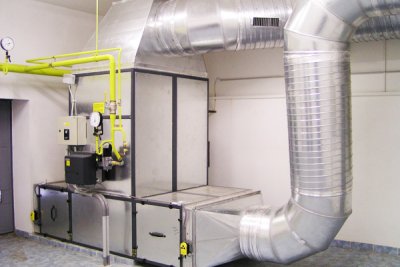
Operation of modern air heating systems is based on heating the air with a heat generator. From it, warm air is supplied to the rooms through air ducts and ventilation grilles.
Cold air is supplied to the heat generator both from the building and from outside through separate air ducts and openings.
Air circulates naturally or forcedly. In the first case, this happens without additional equipment due to the fact that warm air is lighter, it rises, and cold air descends. This scheme is sensitive to the opening of windows and doors. Therefore, forced circulation is often chosen, which is carried out with the help of a special fan.
Advantages
There are several of them:
- economy exploitation;
- efficiency up to 95%;
- fast warm-up premises;
- absence of liquid coolant and associated problems (for example, damage to pipes due to freezing);
- aesthetics (no pipes, radiators);
- possibility with the help of such a system clean, ventilate, condition and humidify the air;
- automation when installing special equipment;
- safety, provided by various sensors;
- saving for partial self-installation.
Flaws
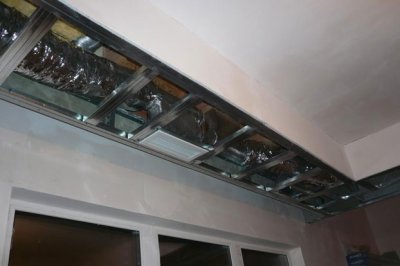
They also exist, these are:
- installation of heating during building construction (otherwise its parts may spoil the interior);
- need for constant control And maintenance;
- high prices in Russia, including due to low prevalence;
- design complexity, related to special calculations;
- energy dependence (in case of interruptions in the central power supply, an additional power source is required).
Scheme of heating a private house with air
The main unit of the system is usually installed in the basement of the house in its center and includes all basic equipment:
- air heater (heat generator);
- fan;
- filter and purifier;
- air humidifier;
- indoor air conditioner unit;
- various sensors.
Not all listed types of equipment are required for installation. The minimum set will not include fan, purifier, humidifier, air conditioner and sensors. From the main unit of the system, often in the center of the house, the main air duct goes up. It supplies heated air to all levels of the building.
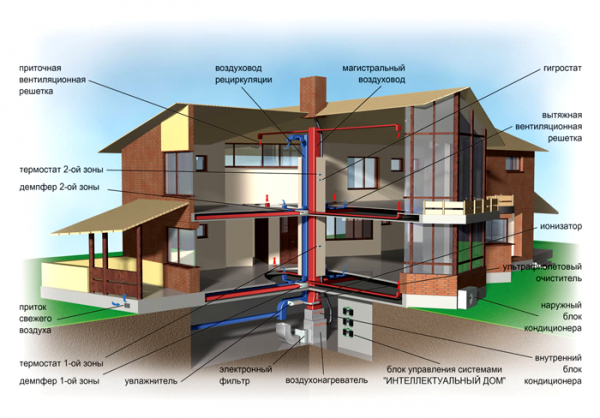
Photo 1. Air heating scheme of a two-story private house. Arrows indicate parts of the heating structure.
Horizontal levels of heating air ducts, are usually located under the floor of each floor, as well as in the ceiling of the upper level, thus covering the building from below as well as from above. Separately mounted air collection system inside and outside the house. The internal air is cleaned and humidified in the main unit, and the external air is used for additional ventilation and renewal.
How to install
There are some tasks involved in installing a system like this that require the help of professionals, and some that some homeowners do themselves. The first ones include:
- calculation and design of the system;
- installation of gas equipment.
The second category includes installation of some parts of the system (air ducts, sensors). This allows you to reduce the cost of organizing heating. It is best to start designing and installing such heating together with the planning of the house, since it is better to hide all the parts in the floors and ceilings, and also immediately allocate a place for installing the main unit.
Sequence of installation of air heating at home:
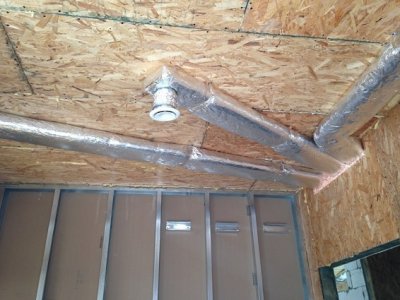
- design systems;
- purchase equipment;
- installation of equipment main node;
- installation main air duct;
- installation other air ducts and grilles;
- installation additional equipment (temperature, humidity sensors);
- commissioning works;
- finishing works, as a result of which the components of the heating system are closed.
Types of air heating
According to the type of heat generator, there are:
- gas;
- on solid fuel;
- Electric air heating.
Usage gas has an advantage due to the low cost of fuel And possibilities of full automation of the system. However, not all private houses in Russia are gasified. In this case, it makes sense to consider installing on the site gas holder — gas storage facilities filled once or twice a year. The significant initial costs will allow you to save on heating for many years.
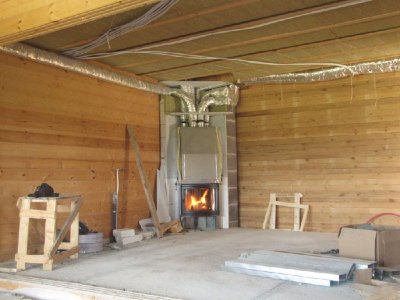
Solid fuel The boiler will allow you to organize more cost-effective heating when equipped.
But operation will require constant fuel loading every 8-12 hours in the cold season.
And here is the complete installation electrified air heating systems in private homes in the Russian Federation are difficult small capacities allocated to such households, which are often insufficient for the operation of electric heat generators.
In addition, it is more expensive to operate than a gas system.
According to the air circulation option, the following are distinguished:
- direct-flow air heating systems;
- recirculation systems: natural type; forced type with supply and exhaust ventilation.
Straight-through
This is a heating scheme that has been known for hundreds of years, in which air heating was carried out in the lower room of the building by burning solid fuel, then through channels in the floors and walls the hot air reached the top of the building and exited through openings at the top.
Peculiarities
In this case the walls and floors of the building are heated to a greater extent. Heat loss is significant, since the entire volume of heated air goes outside.
Operating principles

The movement of air occurs because it heated masses naturally rise upward.
How to do
Initially, according to the diagrams provided on the Internet, the combustion of fuel in this heating system was produced directly on the premises without using any equipment.
At the same time, the air heating temperatures obviously assumed construction of a building only from non-combustible materialsThis is the simplest air heating scheme, but it is rarely implemented, since it is expensive, and the heating parameters are poorly controlled.
Recirculation systems
This scheme does not involve the loss of heated air, as in direct-flow systems, but its circulation inside the building, which is much more economical.
Peculiarities
The use of such systems became possible with the introduction of natural gas heating.With this more environmentally friendly fuel and with the help of special equipment, heated air began to be supplied directly to heated rooms.
Operating principle
The air that was used to heat the room is not discharged outside, but is returned back to the heat generator through the ventilation ducts. Thus, it repeatedly circulates inside the building, which is economically advantageous, but unhygienic. CO accumulates in the rooms2 and dust. There are two options for such systems:
- natural circulation (air masses move depending on their temperature: warm ones up, cold ones down, another name is gravitational);
- forced circulation using supply and exhaust ventilation.
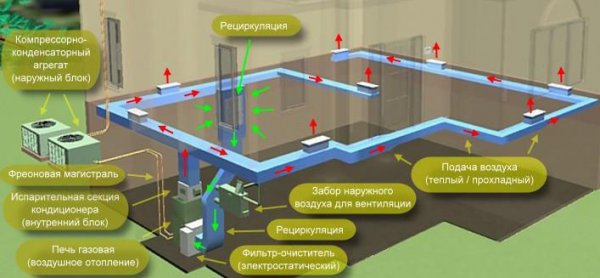
Photo 2. Diagram of a recirculation heating system from a gas stove. The main parts of the design are labeled.
The second option creates a more comfortable environment., allowing for more uniform heating of rooms at different heights from the floor. In general, fully recirculating systems are more suitable for heating non-residential premises, as they do not provide clean, fresh air inside buildings.
How to do
At the bottom of the building is installed heat generator, something is done to it air duct layout in all areas of the building where they are installed ventilation grilles under the ceiling. Warm air from them comes out into the rooms.
Another duct system is installed under the floor, colder air enters its ventilation grilles, which accumulates below under the force of gravity. Through these air ducts, air masses again enter the heat generator and a new cycle begins. The presence of fans for forced air movement helps optimize the temperature regime.
With partial recirculation
This subspecies is most suitable for residential buildings.Some of the heated air circulates inside the building, and some is replaced with fresh air.
Peculiarities
In this heating option include various equipment for complete climate control: temperature and humidity sensors, air conditioners, humidifiers, dehumidifiers, fans.
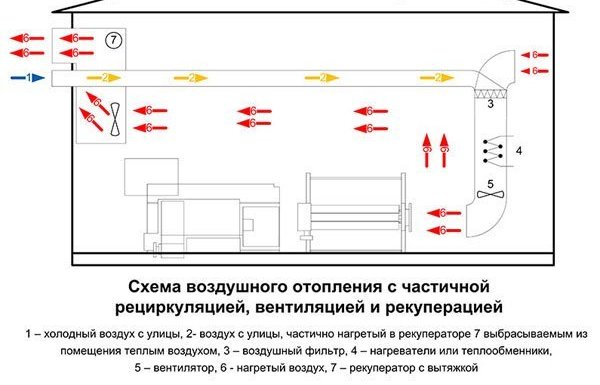
Photo 3. Air heating system with partial recirculation, ventilation and recuperation. Air flow directions are indicated.
Operating principle
The main difference from recirculation systems is presence of external air intakes, and also air outlet holesPlus, additional equipment is built into the circuit to control air movement and its characteristics.
How to do
These are the most complex systems for the design of which It makes sense to invite professionals. Some homeowners carry out partial installation themselves.
Attention! Attraction is a must specialized professionals when installing gas equipment.
The assembly steps correspond to the sequence described at the beginning of the article.
Useful video
Watch the video, which talks about the features of air heating of a private frame house.
Modern and efficient heating option
Cost-effectiveness, providing the required microclimate And controllability makes air heating one of the economical ways to heat a private house. Warming up the rooms and the absence of the risk of freezing water pipes will allow you to comfortably use it in cold Russian winters.









Comments